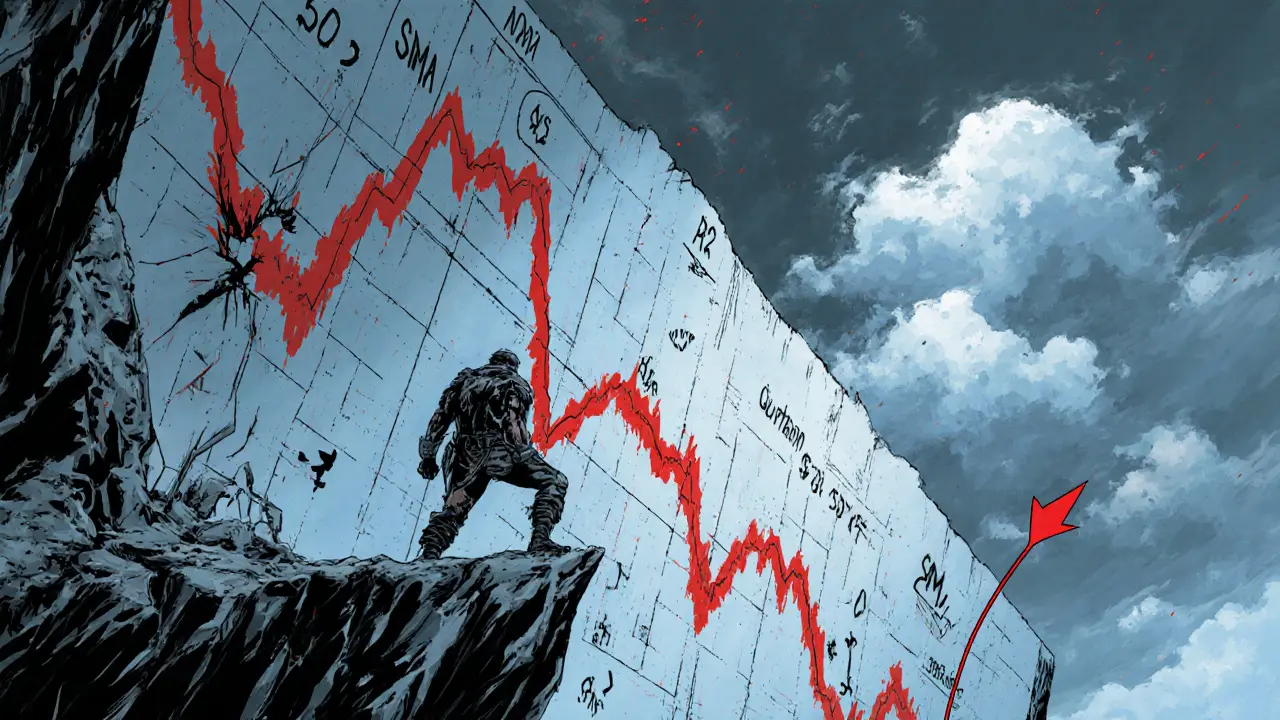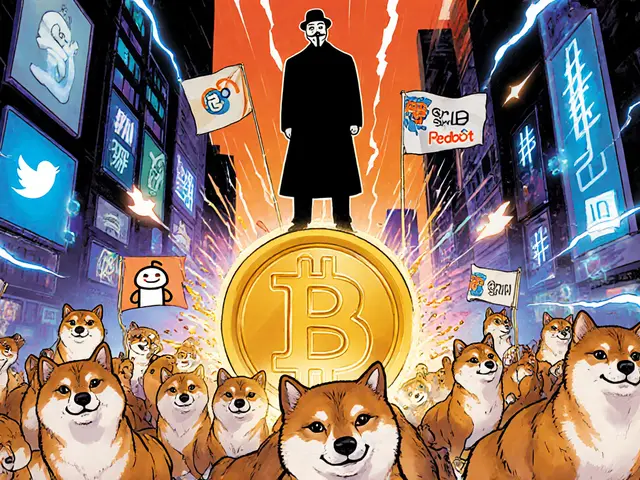- Home
- Cryptocurrency
- What Is Vee Finance (VEE) Crypto Coin? Complete 2025 Overview

What Is Vee Finance (VEE) Crypto Coin? Complete 2025 Overview
VEE Token Price & Risk Analyzer
Risk Assessment Results
Price Trend: Bearish
Liquidity Status: Extremely Low
Technical Signal: Bearish
Risk Level: High
Recommended Strategy: Short-Sell
Potential Loss: Up to 100%
TL;DR
- Vee Finance (VEE) is a micro‑cap crypto with price under $0.00003 USD as of Oct2025.
- Trading volume is essentially zero, meaning extreme slippage and liquidity risk.
- Technical indicators (SMA, RSI) show a prolonged downtrend; short‑selling is the dominant strategy.
- Analyst forecasts predict another 20‑30% drop by year‑end, with a low near $0.000024.
- Invest only if you can afford to lose 100% - the token behaves like a speculative penny‑stock.
What Is Vee Finance?
Vee Finance (VEE) is a micro‑cap cryptocurrency that positions itself in the decentralized finance (DeFi) space. The project released a white paper in early 2023, outlining a token‑based ecosystem for lending, staking, and yield farming. However, by October 2025 there is little evidence of active development, and most exchanges list the token with negligible order books.
Current Market Snapshot
The price discrepancy across data aggregators highlights the thin market. CoinCodex shows a price of $0.00003225, while CoinMarketCap reports $0.00002478. Both platforms list a 24‑hour trading volume of $0, indicating almost no active buyers or sellers.
Key metrics (30‑day window):
- Average volatility: 5.98%
- Positive days: 14 of 30 (47%)
- 50‑day SMA: $0.00003872
- 200‑day SMA: $0.00005538
- RSI: 42.67 (approaching oversold)
Technical Analysis - Why the Downtrend Matters
The Simple Moving Average (SMA) lines sit well above the current market price, a classic bearish signal. The 200‑day SMA at $0.00005538 is more than double today’s price, suggesting that even a strong rally would need to close a significant gap.
The Relative Strength Index (RSI) of 42.67 tells us the token is not yet in the oversold territory (<30), but it is far from the typical “overbought” zone (>70). In practice, the price has been stuck below both SMA lines for months, and each bounce has been quickly swallowed by selling pressure.
Adding to the technical picture, the Fear & Greed Index reads 74 - a “Greed” rating driven by broader market optimism. VEE, however, diverges sharply: while the overall market shows mild optimism, the token’s own indicators stay bearish, reflecting a classic micro‑cap disconnection.
Price Forecasts & Market Sentiment
Algorithmic models from CoinCodex predict a 25.08% drop to $0.00002416 by June2025. The same models show a seasonal high of $0.00004615 in February 2025 and a low of $0.00002371 in November 2025. The projections imply that any short‑term bounce is likely to be brief and followed by renewed decline.
Sentiment analysis paints a mixed picture. The broader crypto “Greed” score suggests investors are hunting high‑risk assets, yet the token’s own metrics (zero volume, bearish SMA/R SI) make it a candidate for short‑selling rather than buying. In other words, the market may be willing to speculate, but the odds are stacked against profit from a long position.

Investment Strategy - Why Short‑Selling Dominates
Given the data, most analysts recommend a short‑selling approach. CoinCodex estimates that short‑selling $1,000 worth of VEE and covering the position on 16September2025 could net roughly $312.90, a 31.29% return, assuming flawless execution and no fees. The strategy leverages the token’s downward bias and taps into the limited upside potential.
For investors comfortable with high‑risk tactics, a disciplined short‑sell with tight stop‑losses can capture the steep decline. However, the absence of a liquid market means placing the trade on a major exchange is nearly impossible; most short exposure would have to come via derivatives or over‑the‑counter contracts, which carry their own counterparty risk.
Tokenomics & Fundraising Background
VEE’s tokenomics remain vaguely documented. The project conducted a seed sale, and platforms like CryptoRank retain records of investor pricing and funds raised, though exact figures are not publicly disclosed. The white paper mentions a total supply of 1quadrillion tokens, a typical figure for ultra‑low‑price micro‑caps designed to generate hype through massive token counts.
There is no clear vesting schedule, burn mechanism, or utility beyond the promised DeFi features, which have yet to materialize. This opacity raises red flags for due‑diligence and aligns with the broader risk profile of many micro‑cap projects.
How to Access VEE - Liquidity Realities
Because trading volume is effectively zero, buying or selling VEE on popular decentralized exchanges (e.g., Uniswap, PancakeSwap) results in extreme slippage-often exceeding 50% for modest trade sizes. The token is listed on a handful of obscure aggregators, and the order books are thin enough that even a single market order can shift the price dramatically.
If you still wish to acquire VEE, the safest route is to locate an exchange that supports direct deposits of the token, copy the contract address from the official white paper, and place a limit order at the current market price. Be prepared for the order to sit unfilled for days or weeks.
Regulatory Perspective
Micro‑cap tokens like VEE can slip under many regulatory thresholds, but the lack of clear compliance documentation means they could be re‑classified at any time. Jurisdictions vary: some treat any token traded for profit as a security, while others only regulate assets above a certain market cap. Investors should consult local laws before committing funds.
Key Takeaways
- VEE trades well below its 50‑day and 200‑day SMAs, indicating a long‑term downtrend.
- Zero 24‑hour volume makes the token highly illiquid and prone to massive slippage.
- Technical indicators (RSI, SMA) and analyst forecasts all point to further price erosion.
- Short‑selling is the only viable strategy for those seeking profit, but execution is hampered by limited market access.
- Risk of total loss is high; treat VEE as a speculative gamble, not a core holding.
Frequently Asked Questions
What is the current price of VEE?
As of 2October2025, VEE token trades around $0.000024-$0.000032, depending on the price aggregator.
Why is the 24‑hour trading volume listed as $0?
Most exchanges that list VEE have no active buyers or sellers, resulting in a near‑zero order book and therefore $0 reported volume.
Can I earn rewards by staking VEE?
The official white paper mentions staking, but no live staking contracts have been deployed, so practical rewards are unavailable.
Is short‑selling VEE possible on major exchanges?
Direct short‑selling is not offered on mainstream platforms because of the token’s illiquidity. Traders would need to use over‑the‑counter contracts or derivative products, which carry additional counterparty risk.
What are the biggest risks of investing in VEE?
Key risks include zero liquidity, bearish technical indicators, lack of development updates, possible regulatory re‑classification, and the chance of total loss.
Cormac Riverton
I'm a blockchain analyst and private investor specializing in cryptocurrencies and equity markets. I research tokenomics, on-chain data, and market microstructure, and advise startups on exchange listings. I also write practical explainers and strategy notes for retail traders and fund teams. My work blends quantitative analysis with clear storytelling to make complex systems understandable.
Popular Articles
17 Comments
Write a comment Cancel reply
About
DEX Maniac is your hub for blockchain knowledge, cryptocurrencies, and global markets. Explore guides on crypto coins, DeFi, and decentralized exchanges with clear, actionable insights. Compare crypto exchanges, track airdrop opportunities, and follow timely market analysis across crypto and stocks. Stay informed with curated news, tools, and insights for smarter decisions.





Hey everyone, just a friendly heads‑up: VEE is a micro‑cap token with basically no liquidity, so you could end up buying at a price and not being able to sell it at all. The risk analysis in the post is spot‑on – bear market, low volume, and a bearish technical signal. If you decide to dip your toes in, only allocate money you can afford to lose, and consider using a stop‑loss to protect yourself. Also, keep an eye on the community channels for any updates on liquidity pools.
What most people don’t see is that VEE is being quietly pumped by a handful of insiders who own the majority of the token supply. The timing of the price spikes always aligns with anonymous wallet movements that are clearly orchestrated. It’s not a coincidence that the "risk analyzer" prints a dire warning right before the next surge. Stay vigilant – you might be walking into a classic bait‑and‑switch.
Investing in VEE is a moral failure. The developers are exploiting naïve investors, pushing a barely‑existent asset while claiming it’s the next big thing. This kind of reckless speculation fuels a toxic culture that values quick profit over community well‑being. If you have any sense of responsibility, steer clear and redirect your capital toward projects with real utility and transparent governance.
Wow, another gem that’s going nowhere.
Listen up, the whole VEE narrative is a façade constructed to lure in unsuspecting traders. They’ve built a false sense of scarcity while the core team sits on a mountain of unrevealed tokens. The market’s reaction is just a puppet show – don’t be that puppet.
Dear community, I wish to express my sincere appreciation for the collective diligence displayed in evaluating VEE Finance. It is incumbent upon us to exercise prudence, particularly when confronted with assets of limited liquidity and heightened volatility. May we continue to support one another in fostering responsible investment practices.
Indeed, the observations articulated by the preceding comment merit exhaustive consideration, for they illuminate a tableau of financial peril that is oft‑overlooked amidst the cacophony of speculative fervor, and, as one might observe, the confluence of negligible trading volume, anemic market depth, and an unequivocally bearish technical outlook collectively engender an environment wherein the probability of capital preservation is depressingly minimal; consequently, it behooves the astute investor to engage in scrupulous due diligence, to scrutinize the provenance of token distribution, to interrogate the veracity of development milestones, and to remain vigilant for any indications of market manipulation, such as abrupt, unannounced liquidity withdrawals or discordant price spikes that defy fundamental analysis, thereby safeguarding one's portfolio from the pernicious ramifications of exposure to a micro‑cap token that, by all accounts, resembles a financial time bomb; in sum, the prudent course of action is to allocate resources judiciously, perhaps redirecting them toward assets of demonstrable utility and robust governance structures, rather than succumbing to the allure of speculative excess.
Hey folks! Just wanted to say that it’s totally okay to be curious about VEE, but remember the golden rule: only invest what you can comfortably lose. If you’re feeling uncertain, maybe start with a tiny amount and watch the market dynamics. You’ve got this!
The tokenomics of VEE appear severely flawed - a dismal market cap, negligible TVL, and an absurdly low liquidity ratio. From a DeFi engineering perspective, the protocol’s architecture lacks any meaningful utility beyond speculative arbitrage, rendering it a high‑risk instrument for any risk‑averse participant.
Allow me to elucidate the intrinsic deficiencies that underlie VEE’s purported value proposition: first, its ostensible utility is nebulous at best, presenting a veneer of financial innovation while failing to deliver substantive interoperability or governance mechanisms; second, the token’s distribution schema is conspicuously opaque, with a preponderance of supply vested in undisclosed wallets, thereby engendering an environment ripe for manipulation; third, the glaring absence of robust liquidity pools not only exacerbates slippage but also imperils any attempt at orderly market exits; forth, the bearish technical indicators, notably the sub‑SMA positioning and deteriorating RSI, collectively corroborate a deteriorating price trajectory; finally, the macro‑economic climate, characterized by tightening monetary policies and waning risk appetite, further diminishes the plausibility of any substantive upside, rendering VEE a quintessential example of speculative folly that discerning investors ought to eschew.
That’s a lot of red flags.
Wow!!! This is exactly why you should read the fine print BEFORE you invest!!! All the data points scream, "Proceed with extreme caution!"!!!
Oh great, another “revolutionary” token that’s *guaranteed* to skyrocket…said no one who’s actually done their homework. VEE’s liquidity is practically nonexistent, its risk level is pitched straight up into the stratosphere, and the whole thing reeks of a classic pump‑and‑dump scheme. If you’re looking for a quick buck, sure, go ahead-just remember you’ll probably be left clutching air. Better to put your money where there’s a real product, not into a glorified meme.
Bottom line: VEE is a risky bet. If you want to try, keep the amount tiny.
In contemplating the ethical ramifications of allocating capital to VEE, one must confront the stark reality that such an investment not only jeopardizes personal financial stability but also tacitly endorses a market ecosystem that thrives on speculative excess and the exploitation of uninformed participants, thereby perpetuating a cycle of moral decay that is antithetical to the principles of responsible stewardship and communal prosperity.
From a coaching perspective, it is advisable to develop a diversified portfolio and to avoid concentration in assets with limited liquidity, such as VEE. This approach mitigates risk and aligns with sound financial planning principles.
Look, I get the hype vibe, but VEE’s fundamentals are as shallow as a kiddie pool. If you’re chasing alpha, you might want to steer clear of this shallow end and target projects with genuine use‑cases and robust tokenomics.